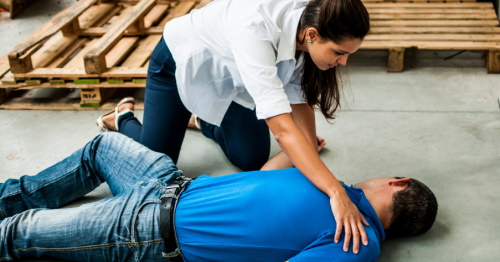Introduction
In times of emergency, the capacity to do Cardiopulmonary Resuscitation (CPR) can be the difference in between life and death. In Australia, recognizing the CPR certification requirements is essential for anybody desiring to become a qualified rescuer. This detailed overview will certainly delve into what you require to understand about mouth-to-mouth resuscitation qualification in Australia, including training alternatives, legitimacy of certifications, age-specific guidelines, and more.
CPR Qualification Demands in Australia: What You Required to Know
What is CPR?
Cardiopulmonary Resuscitation (CPR) is an emergency situation procedure carried out when someone's heart stops beating or they quit taking a breath. It combines breast compressions with rescue breaths to keep blood flow and oxygenation until expert clinical assistance arrives.
Why is mouth-to-mouth resuscitation Important?
The crucial importance of CPR can not be overemphasized-- it saves lives. According to stats from the Australian Resuscitation Council, instant CPR can double or triple a target's opportunity of survival after cardiac arrest.
Understanding CPR Certification
To end up being accredited in mouth-to-mouth resuscitation, people need to undergo training via acknowledged companies. Qualifications generally include hands-on skills practice and academic understanding concerning cardiac emergencies.
Types of mouth-to-mouth resuscitation Educating Available
Basic Life Support (BLS) vs. Advanced Life Support (ALS)
- Basic Life Support (BLS) concentrates on basic methods consisting of chest compressions and rescue breaths. Advanced Life Support (ALS) covers a lot more complex treatments such as innovative air passage administration and medication administration.
Online vs. In-Person Training
- Online mouth-to-mouth resuscitation certification deals flexibility however might do not have hands-on experience. In-person classes give sensible abilities practice essential for reliable action in emergencies.
CPR Qualification Process
Choosing a Training Provider
When seeking training, make certain that your chosen company is approved by trusted organizations like the Australian Resuscitation Council or St John Ambulance.
Course Duration and Content
Most fundamental programs last about 4 hours and cover:
- Adult CPR techniques Use of Automated External Defibrillators (AED) Recognition of heart attack signs
CPR Certification Validity
How Lengthy Does a CPR Certificate Last?
Typically, a mouth-to-mouth resuscitation certification continues to be valid for Click here to find out more 3 years before needing revival. It is critical to remain updated with the latest protocols and guidelines.
Renewing Your Certification
Renewal frequently includes taking a refresher course that reviews essential abilities and updates guests on any kind of modifications in guidelines.
Age-Specific CPR Guidelines Australia
Adult vs. Youngster vs. Baby CPR Techniques
Different age groups call for tailored approaches:
- For grownups, concentrate on compression deepness and rate. For kids, readjust compression depth based on size. Infant CPR technique involves gentle compressions and cautious ventilation.
Infographic: Age-Specific Techniques
|Age|Compression Depth|Proportion|| -----------|-------------------|-------|| Grownups|5-6 cm|30:2|| Children|4-5 centimeters|30:2|| Infants|1.5 centimeters|30:2|
CPR Equipment in Australia
Essential Equipment for Reliable Response
Having accessibility to proper CPR equipment aids successful resuscitation efforts:
AEDs Pocket masks GlovesUsing AED with CPR in Australia
An Automated External Defibrillator can substantially raise survival prices when utilized together with mouth-to-mouth resuscitation-- knowing just Visit this site how to make use of an AED properly is vital for every single rescuer.
Common Misconceptions About CPR
The Misconception of "Mouth-to-mouth Resuscitation Always Restarts Heart"
Many believe that executing mouth-to-mouth resuscitation will constantly reactivate a heart; nonetheless, this is deceptive-- CPR keeps blood circulation till expert aid gets here yet does not ensure revival.
Debunking Various other Misconceptions
Other myths consist of misunderstanding compression depth or the efficiency of rescue breaths versus hands-only techniques; education and learning plays an essential duty in dispelling these falsehoods.
Special Circumstances in Executing CPR
CPR for Drowning Victims
Drowning victims usually call for immediate rescue breaths due to their unique situations; comprehending this context enhances end results significantly.
Sports-Related Heart attack Procedures
Recognizing signs particular to athletes assists responders act rapidly-- education and learning regarding sports-related heart events is essential for trainers and trainers alike.
Workplace Emergency Plans
Establishing Preparedness at Workplaces
Every office should have a thorough emergency situation strategy that includes provision for first aid training like cpr and first aid combo programs for Check out this site employees.
Training Employees Effectively
Regular training sessions make certain team are prepared-- not just does this safeguard employees but likewise improves general work environment security culture.
Frequently Asked Inquiries (FAQs)
Q1: Just how do I discover neighborhood CPR classes?
A1: Regional recreation center or medical facilities typically use classes; websites of companies like St John Rescue offer listings as well.
Q2: Can I obtain my accreditation online?
A2: Yes! Numerous recognized companies supply online cpr certification, however ensure it includes hands-on practice elements as well.

Q3: Exists a distinction in between grown-up and kid certifications?
A3: Yes! Programs especially customized for infants and youngsters focus on age-specific techniques which vary from those taught for adults.
Q4: Exactly how commonly should I restore my certification?
A4: Typically every three years; nevertheless, staying upgraded yearly with refresher courses is very suggested offered progressing guidelines.
Q5: Are there any particular regulations regarding obligatory training?
A5: While policies might differ by state or area, lots of workplaces are needed by regulation to have actually educated very first responders offered on-site during working hours.
Q6: What statistics support the efficiency of CPR?

Conclusion
Understanding the ins and outs of the CPR qualification needs in Australia encourages people across different fields-- from health care specialists to day-to-day residents-- to act emphatically throughout emergencies. With correct training, recognition of age-specific guidelines, understanding regarding devices such as AEDs, and experience with common myths surrounding resuscitation efforts, one can genuinely make a difference when it matters most. Whether you're considering enlisting in neighborhood classes or checking out on-line alternatives like online cpr certification, bear in mind that each action taken towards becoming licensed adds towards conserving lives-- a worthy search indeed!
